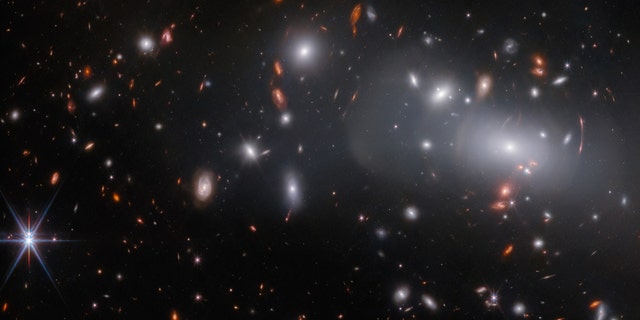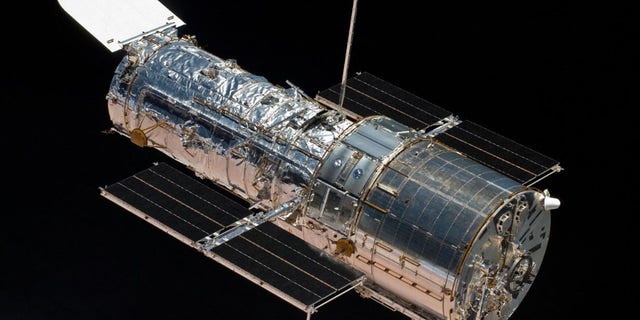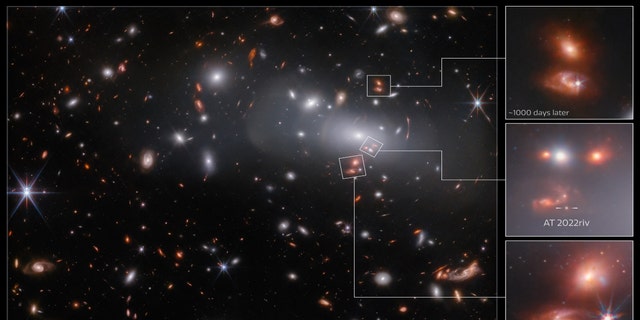The James Webb Space Telescope has captured an image that may make viewers double take.
The shot features a special galaxy cluster – known as RX J2129 – and three different images of the same supernova-hosting galaxy.
RX J2129 is located approximately 3.2 billion light-years from Earth in the constellation Aquarius.
The tripled galaxy is shown this way due to gravitational lensing.
SCIENTISTS REVEAL NEW CLUES ABOUT HISTORIC TYCHO SUPERNOVA

This observation from the NASA/ESA/CSA James Webb Space Telescope features the massive galaxy cluster RX J2129. Due to Gravitational lensing, this observation contains three different images of the same supernova-hosting galaxy, which you can see in closer detail here. Gravitational lensing occurs when a massive celestial body causes a sufficient curvature of spacetime to bend the path of light travelling past or through it, almost like a vast lens. In this case, the lens is the galaxy cluster RX J2129, located around 3.2 billion light-years from Earth in the constellation Aquarius. Gravitational lensing can cause background objects to appear strangely distorted, as can be seen by the concentric arcs of light in the upper right of this image. (ESA/Webb, NASA & CSA, P. Kelly )
Gravitational lensing occurs when a massive celestial body causes a sufficient curvature of spacetime to bend the path of light traveling past or through it – like a vast lens.
The mass and gravity of the galaxy cluster is so great that time and space around it is warped, magnifying, multiplying and distorting galaxies behind it.
The supernova in the triple-lensed background galaxy was discovered by astronomers using the Hubble Space Telescope.

An astronaut aboard the space shuttle Atlantis captured this image of the Hubble Space Telescope on May 19, 2009. (NASA)
NEIL DEGRASSE TYSON SAYS JAMES WEBB SPACE TELESCOPE IS WINDOW TO UNIVERSE ‘NEVER BEFORE ACHIEVED’
It contains a Type Ia supernova. Supernovae are explosions that take place during the final stages of the death of a supermassive star. A Type Ia supernova occurs roughly once every 500 years in the Milky Way and NASA says evidence shows it originates from some binary star systems that contain at least one white dwarf – the small, hot core remnant of a sun-like star.

This observation from the NASA/ESA/CSA James Webb Space Telescope contains three different images of the same supernova-hosting galaxy, all of which were created by a colossal gravitational lens. (ESA/Webb, NASA & CSA, P. Kelly)
The supernovae produce a fairly consistent luminosity, which allows astronomers to calculate astronomical distances. Scientists are able to understand how strongly the galaxy cluster is magnifying background objects and how massive it is.
“As well as distorting the images of background objects, gravitational lenses can cause distant objects to appear much brighter than they would otherwise,” the European Space Agency said in a post. “If the gravitational lens magnifies something with a known brightness, such as a Type Ia supernova, then astronomers can use this to measure the ‘prescription’ of the gravitational lens.”
CLICK HERE TO GET THE FOX NEWS APP
Furthermore, the spectroscopy of the supernova was obtained, allowing for the comparison of the supernova to Type Ia supernovae in the nearby universe.
The agency said that this is an important way to verify that methods of measuring vast distances works as expected.
